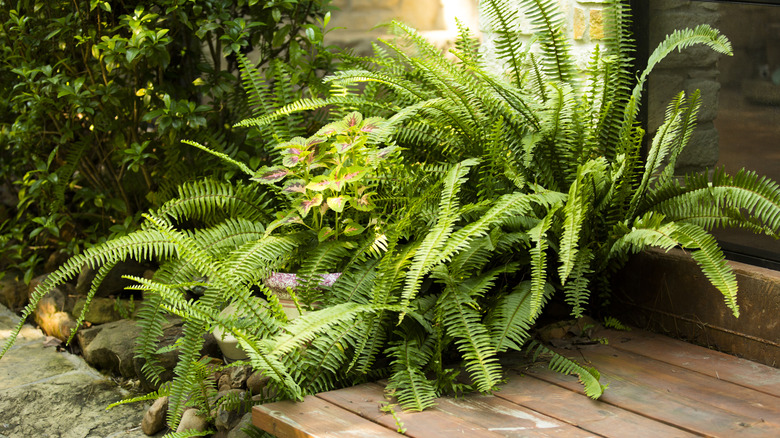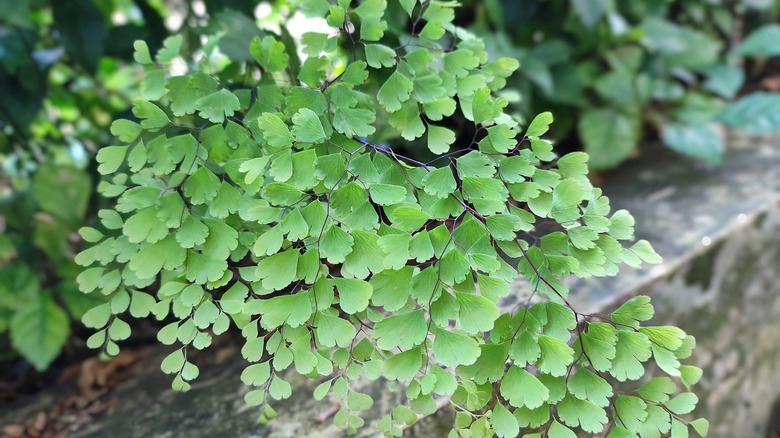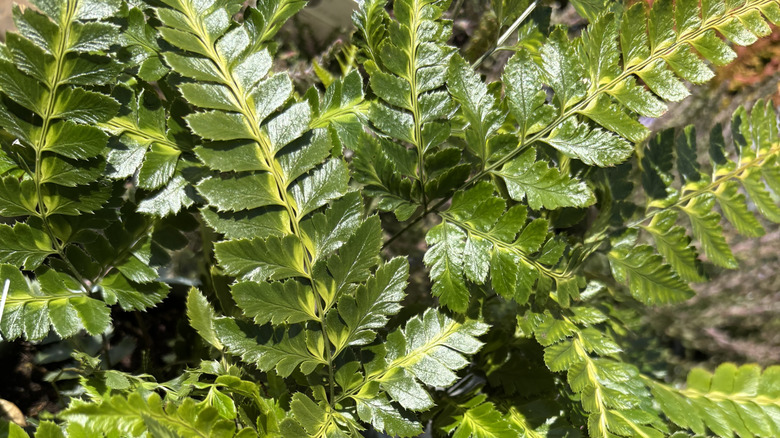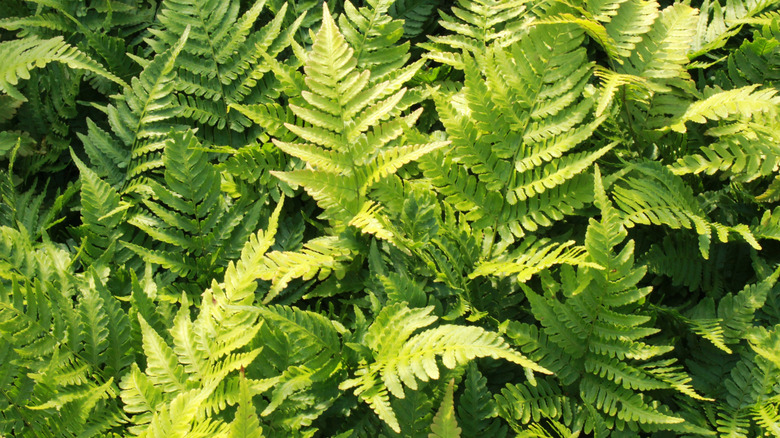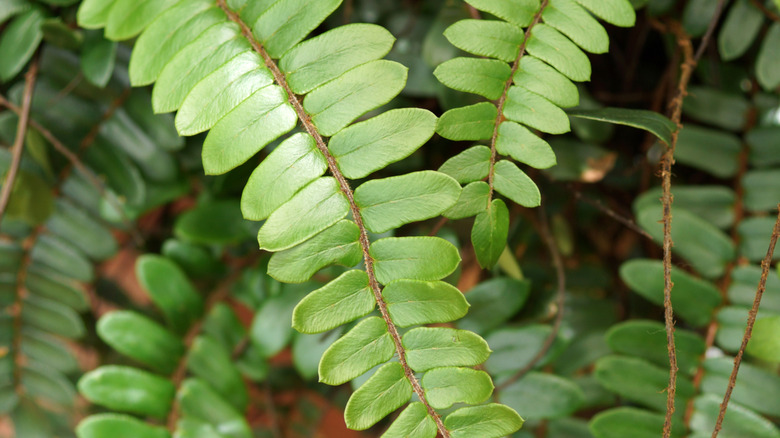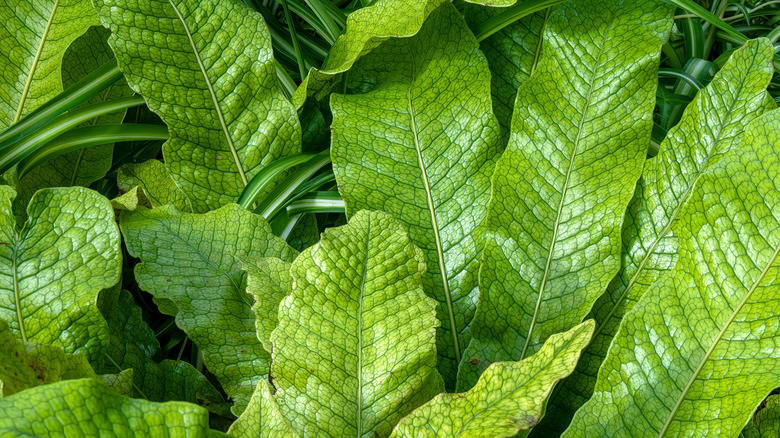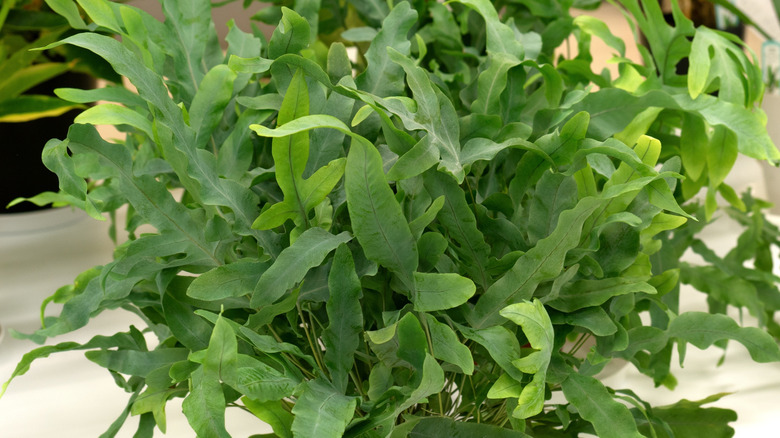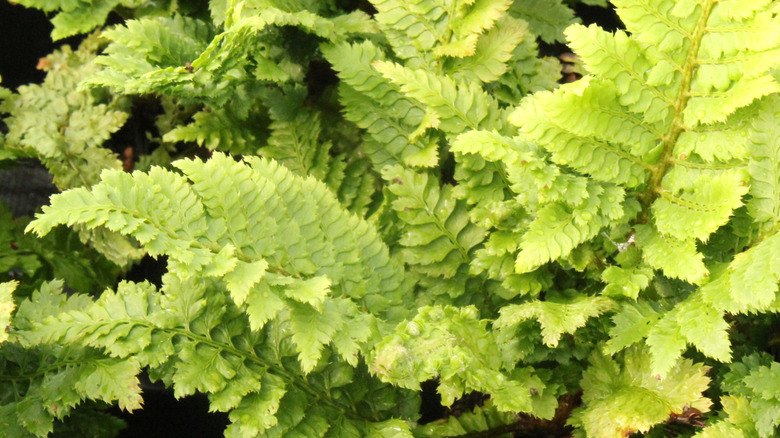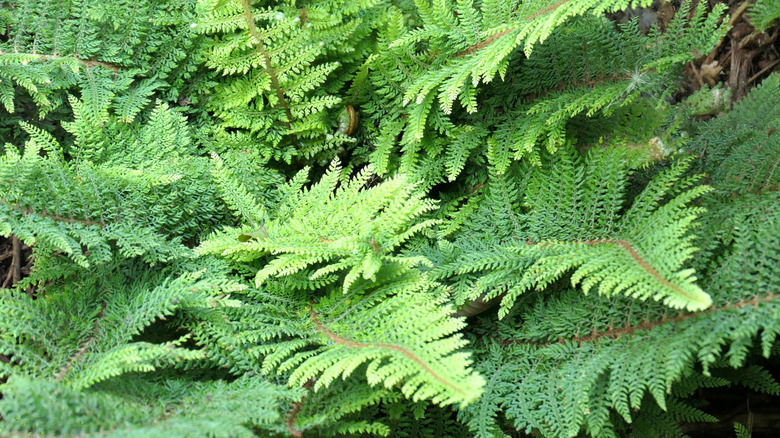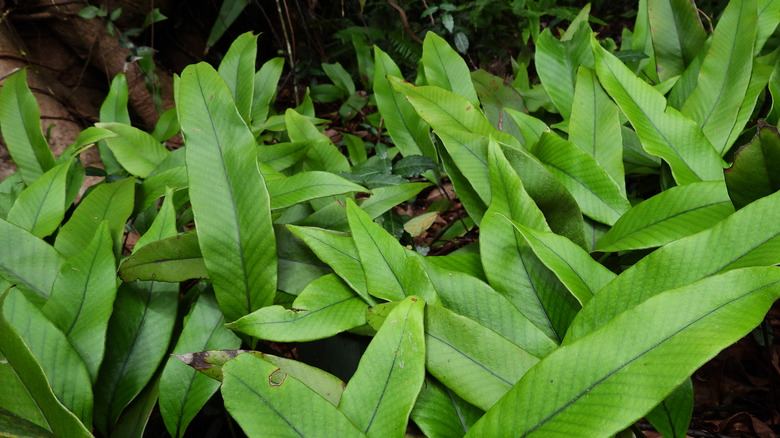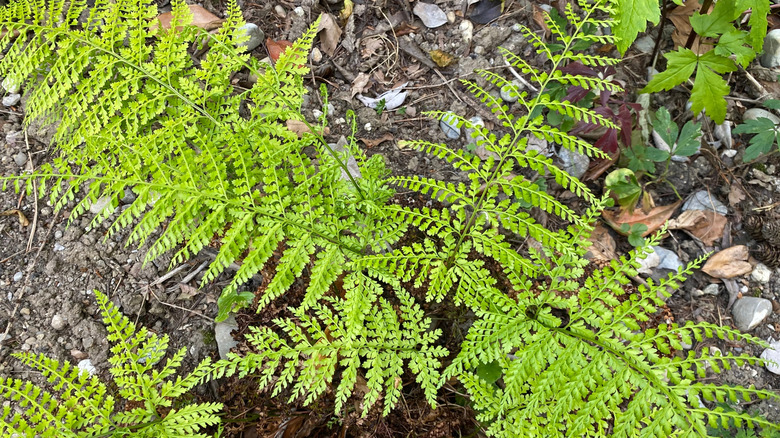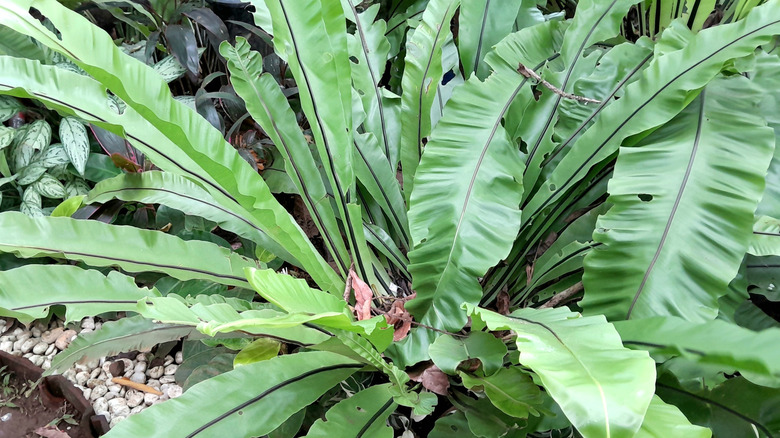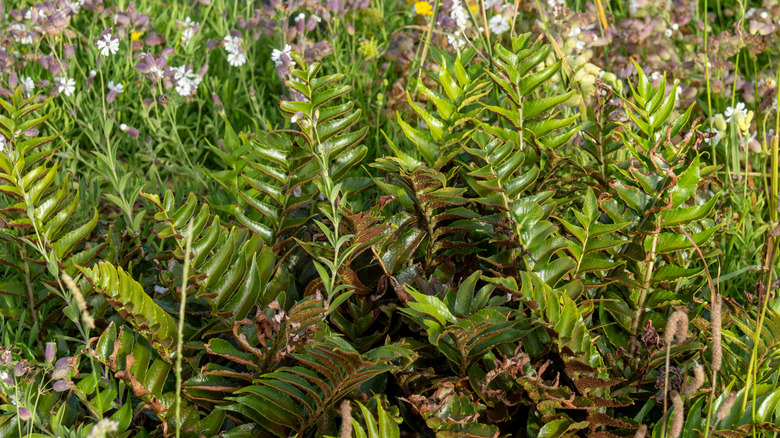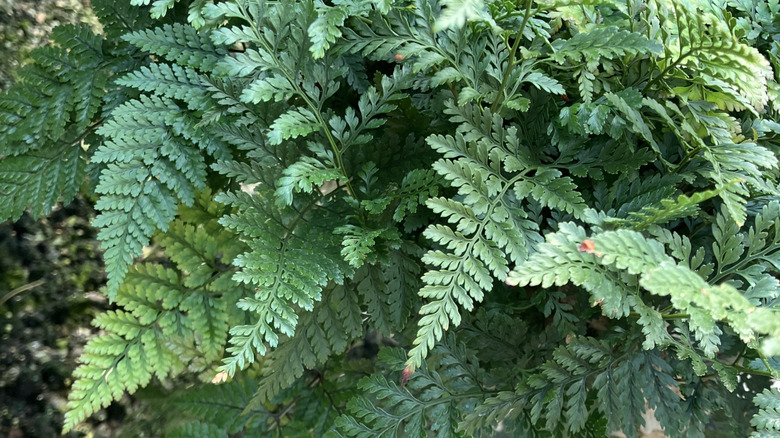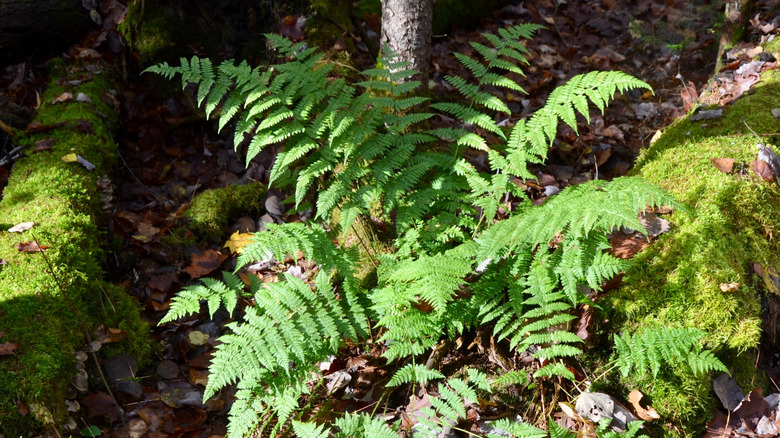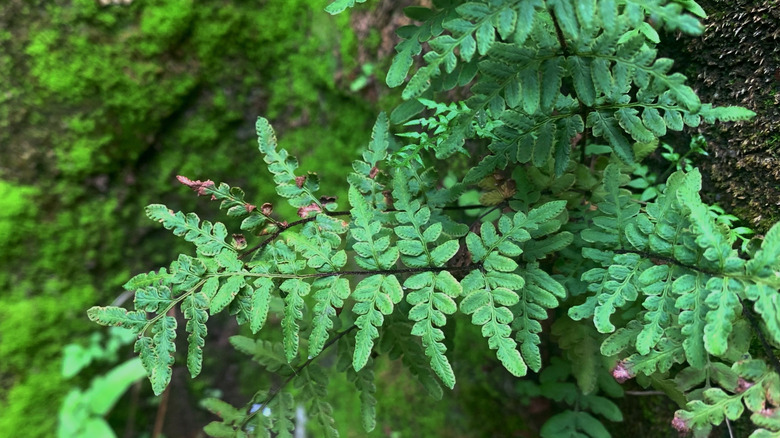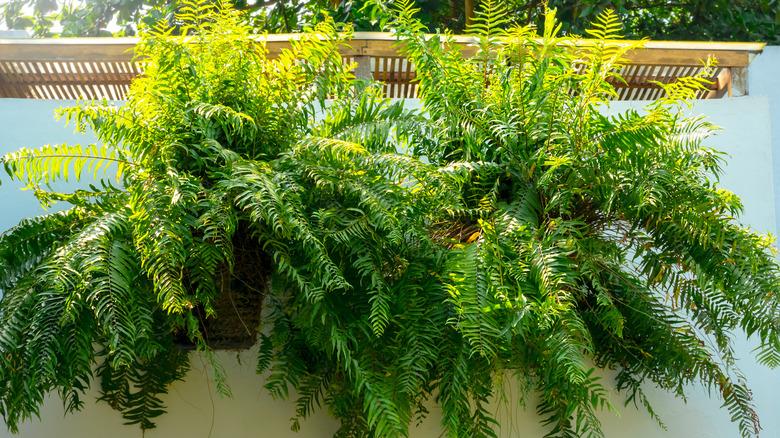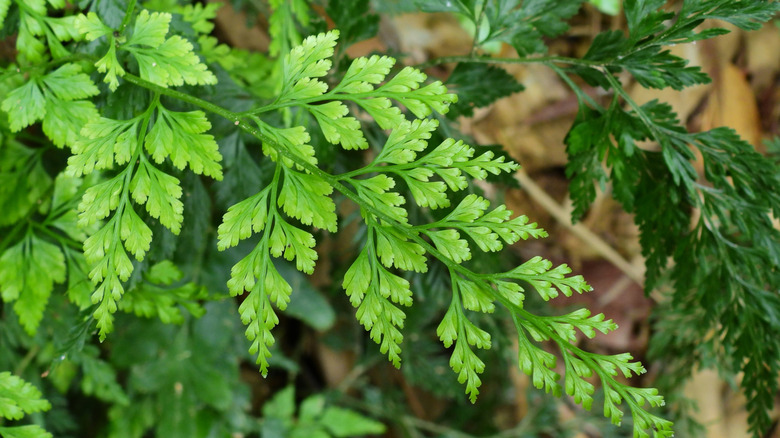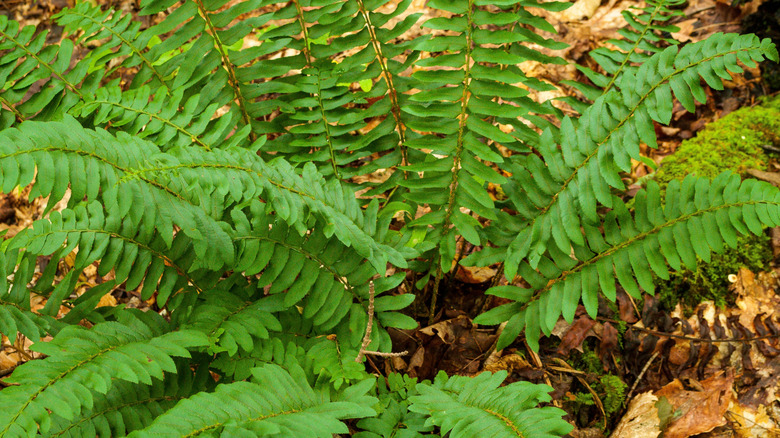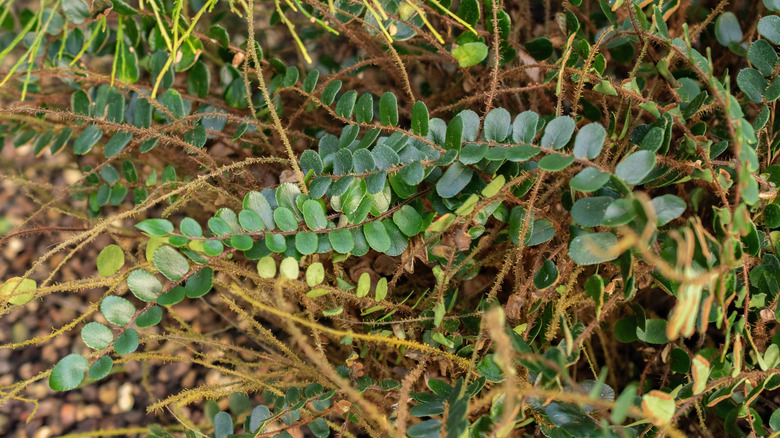The Best Types Of Ferns To Grow On Your Porch For A Beautiful Plant Display
Ferns are often valued for their beauty and ability to soften outdoor spaces, creating a little corner of peace wherever they are planted. Unlike other ornamental plants, many ferns thrive in filtered or shaded light, which can add an incredible amount of variety to porch gardens that don't get full sunlight. Although ferns can make the perfect houseplants, their fronds create a cooling, woodland-like effect that softens porch edges and frames entryways with natural texture. Even the simplest porch can be transformed if you maintain the daily watering and sometimes misting that your ferns need.
The best ferns to grow on your porch are those that thrive in containers, where their arching fronds can be admired up close. When ferns are grown in hanging baskets or pots, their unique foliage can gracefully cascade over the side, adding to your porch's organic appeal. Fortunately, you have many options from which to choose here — from delta maidenhair ferns to the Christmas fern, there are plenty of excellent candidates to adorn your porch with.
Growing your porch ferns in pots or planters gives you more control over how moist their soil is, which is essential for protecting their roots. This setup also makes it easier to move them around as the seasons change. In turn, this flexibility helps them stay comfortable in different temperatures and light conditions.
Delta maidenhair fern
With its lace-like fronds that unfold in dappled light, the delta maidenhair fern (Adiantum raddianum) is perfect for porches. This fern grows naturally in the tropical Americas and the West Indies, and its soft, arching clusters are particularly suited for hanging baskets or containers. Its fragile, triangular green leaflets appear to float in place, contrasting nicely with its wiry, black stalks. It thrives in the damp protection of covered porches and does best in moist, well-drained soil and moderate shade. It's hardy in USDA zones 9b to 10b.
East Indian holly fern
'Variegata' East Indian holly ferns (Arachniodes simplicior 'Variegata') will give any porch a more tropical feel. Originating from Asia, these perennials can grow up to 2 feet tall and 3 feet wide. Their glossy, green leaflets (often adorned with a waxy finish) afford a sculptural appearance that seems almost surreal. When planted in containers, they thrive in any type of shade, from dappled sunlight to deep shade, and need well-drained soil that is rich in organic material.
Japanese shield fern
The Japanese shield fern (Dryopteris erythrosora) is a semi-evergreen perennial that's hardy in zones 5 to 8 and is native to eastern Asia. Its fronds unfurl in a glossy copper-pink shade before maturing to a lush green, creating a soft, layered effect. The fern is a reliable choice for growing on a porch since it thrives in damp, acidic, organic soils and can withstand intense shade. It is low-maintenance and resistant to deer — a nice bonus if any ever venture close to your home.
Sickle fern
Sickle fern (Hemionitis seticaulis) excels in humid, sheltered locations where its glossy green fronds can truly be appreciated. Native to Southeast Asia, New Zealand, and Australia, this perennial grows tidy clusters of arching, leathery fronds that contribute a tranquil aesthetic when kept in containers on a porch. Also suitable for hanging baskets, this fern likes moist, well-drained soil and indirect sunlight and is hardy in zones 10 to 13. Low-maintenance and naturally pest-resistant, sickle fern rewards a touch of humidity and regular misting with year-round greenery that is sure to draw the eye of your visitors.
Crocodile fern
Crocodile fern (Microsorum musifolium) is a remarkable tropical plant that grows beautifully in pots on shaded porches where its patterned fronds can be truly admired. This evergreen perennial, which is native to vast swathes of jungle from southern Myanmar to New Guinea, has long, leathery green fronds with dark, netted veins that resemble the skin of crocodiles. The shiny leaves make a striking yet peaceful display as they arch outward in a neat, clumping pattern. Thriving in warm, humid conditions and favoring indirect light, crocodile fern flourishes best in moist, well-drained soil in zones 10 to 11.
Blue star fern
With blue-green fronds that will layer over the side of any container once established, the blue star fern (Phlebodium aureum) is a beautiful choice for pots on porches in the shade. This perennial is native to the American tropics and grows from creeping, golden-scaled rhizomes, which add to its unique appeal. The leaves are deeply lobed and usually appear bright green to gray-green. The blue star fern grows in zones 8 to 13 and prefers humid air, indirect sunlight, and moist soil.
Western sword fern
The Western sword fern (Polystichum munitum) looks great in pots where its broad fronds stand out against muted backdrops. This evergreen perennial, which is native to the forests of western North America, has green fronds that curve outward in an elegant, erect form. It can grow up to 4 feet tall in thick clumps. Each leaflet has a sharp, toothed edge — the element that inspired its name. Sword fern grows in zones 5 to 9 and is partial to full shade and wet, well-drained soil.
Soft shield fern
The soft shield fern (Polystichum setiferum) will thrive in a porch planter in the shade. It has fronds that spill outward in a soft green whirl, growing up to 3 feet in height and width. Each lance-shaped frond grows from a central crown covered in cinnamon-brown scales, creating an almost feathery appearance. This fern is hardy in zones 6 to 8; it's semi-evergreen in the colder parts of the range and evergreen in the warmer parts. Strong sunshine causes it to turn yellow, so grow it in partial to full shade and soil that's rich and well-drained.
Felt fern
With its tall, leathery fronds, the felt fern (Pyrrosia lingua) is a lovely evergreen to add to your porch. It grows well in containers in the shade. Each frond stands about a foot tall, tapering from base to tip and covered in soft, silvery hairs that give the plant its distinctive felt-like surface. It grows slowly and spreads via creeping rhizomes, making it ideal for hanging displays or tiny pots. It is native to Asia and the Old-World tropics and is hardy in zones 8 to 10. Grow it in well-drained, bark-based soil and dappled shade.
Upside-down fern
In a shady porch pot, the upside-down fern (Arachniodes standishii) adds a touch of the unexpected. Originally from East Asia, this semi-evergreen perennial is enjoyed for its distinctively shaped, finely divided fronds that twist at the base so the upper side faces downward. With uniformly moist, slightly acidic soil, it grows well in partial to deep shade and reaches a height of approximately 2 feet with a stylish spread. When grown in its preferred zones of 4 to 8, gardeners can expect a velvety, layered mound with sluggish, creeping rhizomes.
Bird's nest fern
Bird's nest fern (Asplenium nidus) is a bold statement to grow in any shaded porch pot. Native to tropical regions from Southeast Asia to Australia, this evergreen perennial forms a striking rosette of glossy, bright green fronds that arch outward like unfurling ribbons. The plant has a sculpture-like appearance thanks to the leathery leaves' soft waves around the edge and black midrib. It grows best in rich, moist, well-drained soil and thrives in warm, humid environments with indirect sunshine. This year-round evergreen fern is hardy in zones 11 to 12.
Holly fern
Holly fern (Cyrtomium falcatum) has shiny, dark green leaves that arch from its center, with each leaflet resembling a small holly leaf thanks to its gently serrated edges. Originating in eastern Asia, this semi-evergreen perennial develops tidy clumps that reach heights of 2 to 3 feet and flourishes in partial to full shade. It thrives in moist, humus-rich soil and can withstand humidity, salt, and even brief dry periods. Hardy in zones 6 to 11, holly fern maintains its vibrant color throughout the year in mild climates, providing a refined, evergreen appearance to containers and sheltered areas.
Rabbit's foot fern
The rabbit's foot fern (Davallia solida var. fejeensis) is a great choice for a porch fern. In pots, its leaves emerge from silvery rhizomes, which spread across the soil and cascade down the sides of its container. It's native to Fiji and the Caroline Islands, where it flourishes in bright, indirect light and temperatures above 55°F. It thrives in a peat-based mix that drains well and enjoys regular misting. This fern is hardy in zones 10 to 12, but you can grow it on sheltered porches where it can be shielded from the cold.
Evergreen woodfern
The evergreen woodfern (Dryopteris intermedia) is a resilient native fern that adds a touch of greenery throughout the year to a shaded porch or patio. Its delicately divided, arching leaves create a dense, mounded appearance, giving your home some woodland ambiance. The leathery leaves remain semi-evergreen during milder winters, with new growth emerging when spring arrives. It grows well in moist, rich, acidic soil and can tolerate deep shade and dappled sunlight. This fern is ideal for any porch in zones 3 to 8 and has low maintenance needs.
Hairy lipfern
The hairy lipfern (Hemionitis lanosa) is a compact fern native to central and southeastern United States that will have no problem growing in a container on your porch. Its dark green fronds, which are adorned with fine, soft hairs, create a gentle shimmer when light hits them, while the reddish-brown stems provide a unique appearance among shade-loving plants. Unlike many other ferns, it can handle full sun as long as the soil remains moist and well-drained. This perennial plant, which grows to about a foot in height, thrives in acidic, rocky, or loamy soil in zones 5 to 8.
Boston fern
The Boston fern (Nephrolepis exaltata) is a classic choice for a porch, where its green fronds will create a gentle, flowing appearance. If you decide to hang it in a basket, look out for this hanging plant mistake that can kill your Boston fern. Originating in the tropical and subtropical parts of the Americas, this perennial grows best in bright, indirect light and requires consistently moist soil. Each leaf of the fern can grow up to 3 feet in length. With its dainty leaflets and light structure, it is perfect for shaded, humid settings in zones 9 to 11.
Carrot fern
Carrot fern (Onychium japonicum) is an airy-looking fern with finely divided fronds that look like carrot tops. Each one of its leaves emerges on slender black stems from a compact clump, giving the plant a light and airy look. This perennial is native to Asia and can grow well in partial to deep shade with moist, well-drained, organic soil. In cooler regions, bring the potted plant indoors for the winter. Carrot fern typically reaches about 18 inches in height and width. It's hardy in zones 9 to 10.
Christmas fern
The Christmas fern (Polystichum acrostichoides) is a fantastic option for a shaded porch planter, adding year-round greenery and a refined shape to the area. Its leathery, lance-shaped fronds remain a deep green even during winter, arching from a dense, upright clump that can grow up to 3 feet tall and wide. Each spring, new silvery fiddleheads appear, providing a fresh appearance as the seasons transition. This low-maintenance perennial is native to eastern North America and is hardy in zones 3 to 8, preferring rich, well-drained soil and dappled or full shade.
Button fern
The button fern (Hemionitis rotundifolia) is a delightful option for a porch that has room for hanging baskets and not just ground containers. Ferns are some of the best hanging plants for your outdoor space, and this fern's fronds will cascade softly over the edges of containers, each adorned with shiny, round leaflets. Approximately a foot in height and width when established, this compact evergreen perennial originates in New Zealand. Hardy in zones 9 to 11, the button fern enjoys filtered light and shelter from strong winds. It prefers partial shade and well-drained soil.
